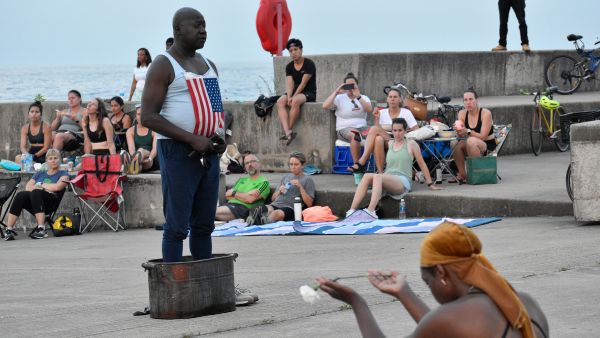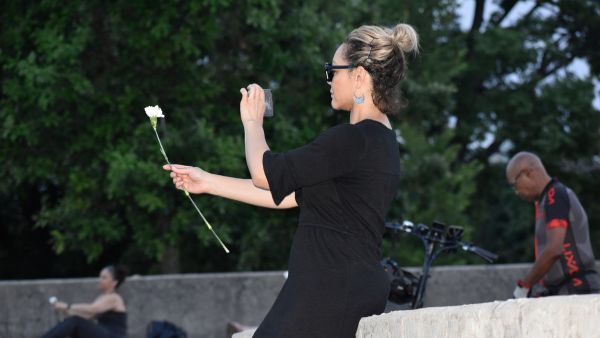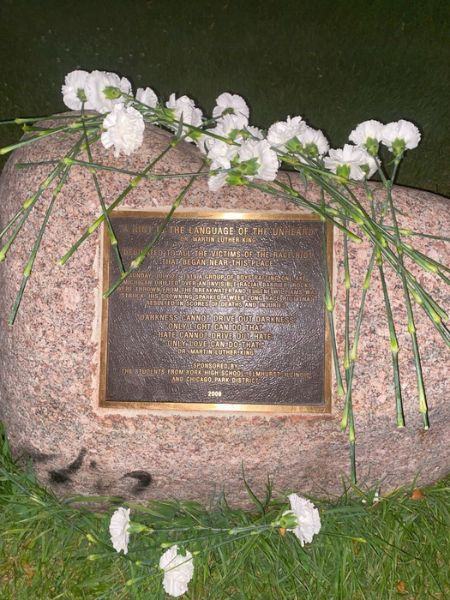Photos by Tacuma Roeback
There is an origin story in Chicago so potent and pervasive that its effects not only reverberate through time but, because of its occurrence, healing and reconciliation remain necessary to this day.
The originating event is the Chicago Race Riot of 1919, which claimed 25 Black lives and 13 White ones. The riot remained the worst incident of racial violence in the city’s history, one of 25 nationwide disruptions that occurred that summer where White people perpetrated racist mob violence against Black people.
Last week, a bike and trolley tour explored the sites connected to the riot while examining its rippling effects that echo into the present day.
On Thursday, Arkey Adams, on behalf of Lookingglass Theatre, curated “Sunset 1919,” a healing ritual and performance near the site of the incident that sparked the riot 104 years ago — the murder of Eugene Williams by a White man named George Stauber.
Dozens of people came out to the South Side Chicago lakefront to take part.
A Ceremony and Elegy
On a concrete walkway abutting Lake Michigan, the ceremony began with prayer and a “smudging” ritual conducted by Lookingglass Playwright in Residence J. Nicole Brooks and First Nations Garden co-founder Fawn E. Pochel, respectively.
And then, near the site where Stauber stoned Williams for inadvertently drifting into Lake Michigan’s “Whites only” territory, a demonstration of music, dance and spoken word commenced.
With his flute and congas, Adam Zanolini provided a sparse and somber elegy to the spirit-guided movements of Ugochi Nwaogwugwu and the plaintive poetry of Marvin Tate.
Finally, in honor of the dead from the Chicago riot and the uprisings across the nation, Nwaogwugwu, barefoot and in a white ceremonial dress, pirouetted and moved toward the edge of the walkway to drop a single white carnation into Lake Michigan, close to where Williams drowned.
“Before I came out here,” said Nwaogwugwu, “I prayed that what people needed to see, hear, and feel would come through me. And that is what I think happened.”
“The only thing I knew to do was to throw the flower into the water. Everything else we did in the moment,” Nwaogwugwu said about her collaboration with Zanolini and Tate.
Zanolini echoed her sentiment.
“What we wanted to do is respond to the moment and respond to each other and just make a sound and a performance that really reflects the energy here.”
Brooks and others handed out white carnations to people in attendance. Many were laid at the nearby “Eugene Williams Memorial” marker with the inscription, “Dedicated to All the Victims of the Race Riot That Began Near This Place.”
And when the “Sunset 1919” ceremony concluded, DJ Lady D got on the ones and twos to conduct her own healing ritual, a House music dance party.
The extent of healing from this event is impossible to comprehend.
Yet, that night, the prayers, rituals, performances and party all felt like a release.

The artists and organizers of Lookingglass Theatre’s “Sunset 1919” gather before the start of the event.

Fawn Pochel lights sage and other herbs at the start of the “Sunset 1919” healing ritual.

Ugochi Nwaogwugwu engages in spirit-led movement to start the program.

Adam Zanolini plays somber notes on his flute to honor the life of Eugene Williams and others lost to the Chicago Race Riot of 1919.

Nwaogwugwu engages in movement as Marvin Tate belts out spoken word.

Tate delivers impassioned poetry calling for “No more Red Summers” while advocating for the lives of Black children.

J. Nicole Brooks kneels with a white carnation as Tate closes his eyes, perhaps a prayer for all the lives lost.

Nwaogwugwu moves to the edge of Lake Michigan to drop a single carnation near where Eugene Williams drowned, sparking the 1919 race riot.

One of the “Sunset 1919” attendees takes a picture of her carnation.

Attendees placed their carnations on the nearby “Eugene Williams Memorial” historical marker.

DJ Lady D capped the night off with a much-needed House music dance party.